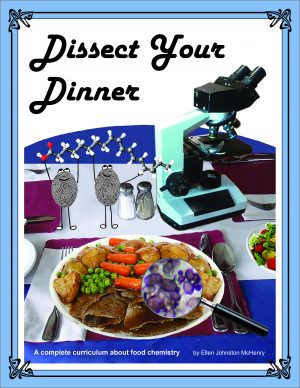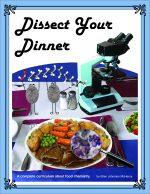Dissect Your Dinner; Student text (paperback)
$16.95
IN STOCK!
Please order from an online book seller.
- Description
Description
To order, please order from one of these online book sellers if you can. (I am trying to reduce the packing and shipping aspect of my business and also make shipping less expensive for you.) If you can’t order from one of these, contact me: ejm.basementworkshop@gmail.com.
Amazon.com, BarnesandNoble.com, booksamillion.com, ThriftBooks, etc.
NOTE: You can also order through your local book store– they can put in an order for you.
SECOND NOTE: I can’t control the price offered by these other book sellers. I apologize their prices are slightly different from the one listed here.
* * * * * * * * * * * * * * * * * * * * * * * * * * * * * * *
This is a complete curriculum about food chemistry for ages 10 to 16.
FREE SAMPLE CHAPTERS:
Here is a summary of what is in each chapter:
Chapter 1: Structure of water molecule, structure of atoms, why water is a polar molecule, the chemistry of salt NaCl, the structure of a glucose (simple sugar) and sucrose (combination of glucose and fructose), definition of enzymes, and a look at how the enzyme sucrase tears apart sucrose.
Chapter 2: Carbonation, carbon dioxide, dissolved gases, mixtures, caffeine molecule, benzene ring, artificial colors, preservatives such as potassium benzoate and sodium benzoate, phosphoric acid, water’s ions (hydrogen ion and hydroxide ion), pH definition and the pH scale, pasteurization, homogenization, lactobacillus, the proteins in milk, peptide bonds, peptidases, lactose and lactase, colloids, the Tyndall effect.
Chapter 3: How butter is made, the beta-carotene molecule and how it is chopped in half to form two retinols, triglycerides, protein micelles in milk, chemistry of curdling milk, microorganisms in cheese, lactic acid fermentation by bacteria, ethanol fermentation by yeast, amylose and amylopectin starch, amylase enzyme, amino acids, the chemistry of the protein gluten and why it creates problems, the Maillard reaction, leavening with baking soda and baking powder.
Chapter 4: Emulsions and emulsifiers, anatomy of leaves, chloroplasts, chlorophyll, phtyochemicals (polyphenols such as flavonoids, resveratrol, curcumin, tannins), the history of the discovery of vitamins and information about the vitamins, comparison of type of salad greens (iceberg, red leaf, endive, spinach), fiber, microbiome in our gut, cellulose and cellulase.
Chapter 5: Capsaicin, anatomy of bean pods and seeds, chemistry of bean seeds (oil bodies, protein bodies, starch granules), endosperm, phytohemagglutinin, raffinose in beans, solanine in potatoes and other nightshades, potatoes and sweet potatoes, microscopic comparison of starch granules, the anatomy of muscle tissue, myoglobin, hemoglobin, omega-3 fatty acids, saturated and unsaturated fats, cis and trans fats, plant-based meats and leghemoglobin taken from soybean roots.
Chapter 6: Anatomy of eggs, chemistry of beating egg whites (meringue), why eggs can make custard, thickening with starches, vegetable shortening, hydrogenating oils, physics of pie crust, collagen-based gelatins, apsics, history of Jell-O, why whipped cream gets thick, agar, pectin, carrageenan, chocolate (theobromine), caffeine, types of sugar, caramelization, menthol, xylitol, stevia, artificial sweeteners.
FAQ’s:
1) What is the difference between this book and the other listing for Dissect Your Dinner? This student text IS INCLUDED in the other book (the one that sells for over $30). This separate student text is for parents or teachers with multiple students and would like each student to have their own copy of the text.




